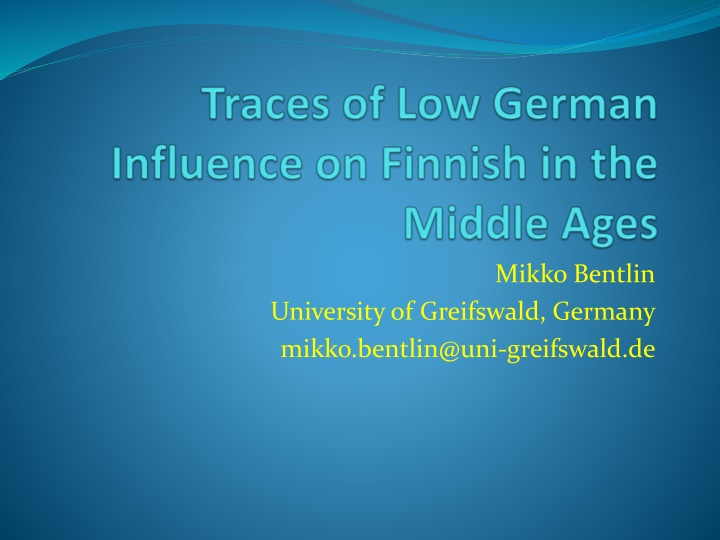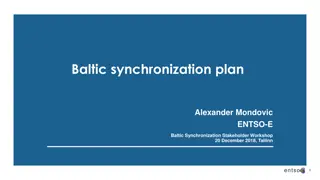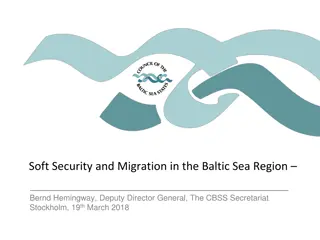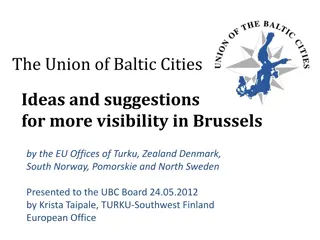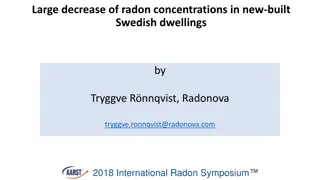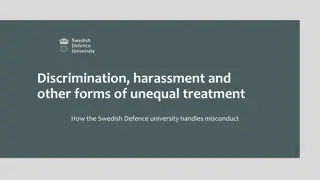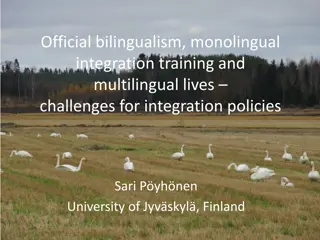Influence of Low German on Swedish Development in the Baltic Region
The history of Finland in the 12th century, the incorporation into the Swedish realm, Christianization, and economic shifts due to Hanseatic League dominance are depicted. The chronology of Low German, its separate language development within the Germanic branch, and its decline with the Reformation and Luther's Bible translation are explored. The impact of Low German on Swedish administration and economy, as well as the distinction criteria between Swedish and Low German influence, are discussed.
Uploaded on Sep 25, 2024 | 3 Views
Download Presentation

Please find below an Image/Link to download the presentation.
The content on the website is provided AS IS for your information and personal use only. It may not be sold, licensed, or shared on other websites without obtaining consent from the author.If you encounter any issues during the download, it is possible that the publisher has removed the file from their server.
You are allowed to download the files provided on this website for personal or commercial use, subject to the condition that they are used lawfully. All files are the property of their respective owners.
The content on the website is provided AS IS for your information and personal use only. It may not be sold, licensed, or shared on other websites without obtaining consent from the author.
E N D
Presentation Transcript
Mikko Bentlin University of Greifswald, Germany mikko.bentlin@uni-greifswald.de
Finland in the 12thCentury Politics: Incorporation into the Swedish realm Religion: Christianization from both East and West Economy: Beginning domination of the Hanseatic League around the whole Baltic Sea, combined with German eastward expansion on the Southern and Eastern shores Finns came intocontactwith Low-German speakers on all theseareas of life
Swedish Norwegian Finnish EstonianRussian Livonian Visby Latvian Denish L beck
Chronology of Low German Separate language within the West Germanic branch of Germanic, Fi. alasaksa, Germ. Niederdeutsch Old Saxon = Old Low German about 800 1150/1200 AD, had great similarities with Old Dutch, being at the same time rather different from Old High German. Gap in documentation between appr. 1150 and 1250 Middle Low German about 1250 1600, always under pressure from the more prestigious High German
Chronology of Low German (2) Reformation and Luther s Bible translation speeded up the decline of Low German as a literary language In the Baltics, the use of Low German ended quite rapidly because there were almost no native speakers in the numerally larger lower classes and thus no relevant dialectal basis for further development Even in areas with Low German-speaking majorities, the language lost its position as written standard.
Swedish or Low German? A great part of the Swedish lexicon is of Low German origin Swedish was the language of administration and dominated up to the 20th century Influence from both Standard Swedish and Swedish dialects spoken in Finland Low German was the dominanat language in economic affairs The institution of the city was introduced according to German models and until 1471 Germans were supposed to hold half of the posts in city councils and mayors offices
Possible distinction criteria 1. Phonetical criteria: Difficult, because most possible Swedish and Low German originals are more or less identical Remarkable exception: Sequence /ouv/ (e.g. in rouva 'lady', touvi 'rope') points to Low German origin Germanic feminine nouns ending in a vowel that has been replaced by Fi. -u/-y e.g. Fi. lykky 'luck' as Swedish retained -o/-u in oblique cases much longer than Low German
Possible distinction criteria 2.) Semantic criteria Non-existence of a word in either Low German or Swedish: E.g. Fi. dial. laatta 'sand bank' should be of Low German origin, while laatta 'plate' can be borrowed from either Swedish or Low German
Possible distinction criteria Most Low German borrowings in the fields of a) Church and Christian religion (kirkko 'church', rauha 'peace', ?sielu 'soul') b) Fishery (monni 'wels catfish, silurus glanis', rys 'fish trap') c) Craft, trade and urban life (ammatti 'profession', rouva 'lady', r t li 'tailor')
Possible distinction criteria 3.) Distributional criteria Most obvious Low German loans are found in South Eastern dialects that historically belonged to the economical hinterland of the city Vyborg (Viipuri). Another gate into Finland may have been the valley of the River Kokem enjoki where some words of Low German origin must have lived for centuries without spreading into other Finnish dialects. (e.g. asikko 'small salmon or trout', katve 'shadow')
Conclusion Low German loanwords in Finnish open quite a new perspective on cross-cultural contacts in the Baltic Sea area as well as the history of both languages. Low German loanwords in Finnish cover a wide range of medieval everyday life. Borrowed conjunctions and particles such as ent and vaan seem to have had some structural influence on Finnish. Low German loanwords are obviously more numerous than than e.g. the more widely known Indo-Iranian loanword layer in Finnish.
